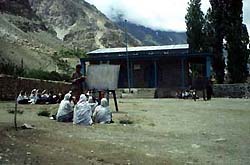2. Religious Centers and Social Services
 |
| A Jamatkhana can be found
in the center of every Ismaili village. |
Let us look more deeply at an Ismaili village landscape. In the regions where
the Ismailis are dominant, you never fail to find houses of worship that double
as assembly places, called “Jamatkhana,” in the center of villages.
The building with the light-blue pillars in the background of the picture below
is one of these “Ismaili mosques.” In this particular village,
in the front yard of the building, school lessons are being provided by an
NGO affiliated with the Aga Khan Foundation. Because the school building is
humble and small, the lessons are often held outside when the weather is nice.
The girls in the picture are studying Urdu or Pakistan’s national language,
and arithmetic. Children from families belonging to other religious sects study
together with those of the Ismailis. The Ismailis provide religious education
outside of the schooling system.
Villages in the narrow valleys have little level ground that remains as empty
lots. The site of the Jamatkhana is shared by a medical clinic run by the Aga
Khan Foundation. Since educational and medical facilities are located on the
same site, the religious center plays a central social function. The organizations
are run by experienced staff with strong administrative abilities. At the same
time, these organizations are supported by volunteer activities by village
people.
